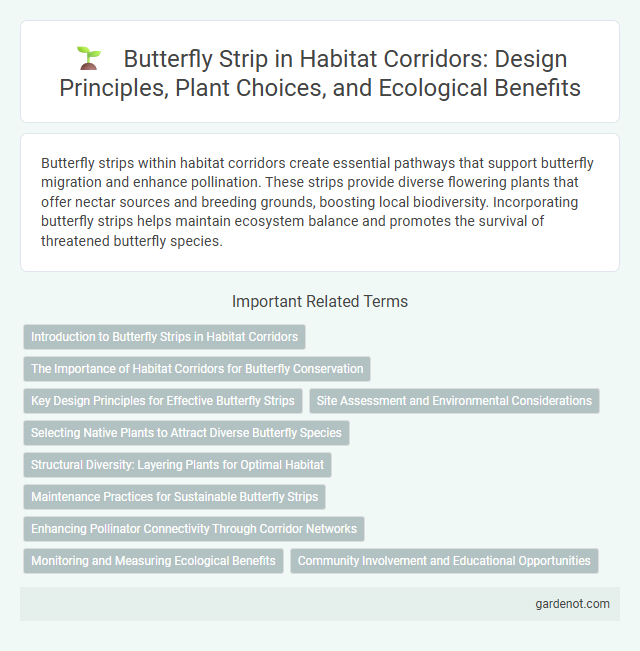Butterfly strips within habitat corridors create essential pathways that support butterfly migration and enhance pollination. These strips provide diverse flowering plants that offer nectar sources and breeding grounds, boosting local biodiversity. Incorporating butterfly strips helps maintain ecosystem balance and promotes the survival of threatened butterfly species.
Introduction to Butterfly Strips in Habitat Corridors
Butterfly strips are specialized habitat corridors designed to support pollinators by providing continuous resources such as nectar, host plants, and shelter. These strips enhance biodiversity by facilitating butterfly movement and reproduction across fragmented landscapes. Incorporating native wildflowers and grasses within butterfly strips increases their effectiveness in promoting ecological connectivity and conservation.
The Importance of Habitat Corridors for Butterfly Conservation
Butterfly strips serve as vital habitat corridors that connect fragmented ecosystems, allowing butterflies to migrate, find food, and reproduce effectively. These corridors increase genetic diversity by facilitating gene flow between isolated populations, reducing the risk of inbreeding and local extinctions. Conserving and restoring butterfly strips enhances pollination services and supports overall biodiversity within agricultural and urban landscapes.
Key Design Principles for Effective Butterfly Strips
Butterfly strips must incorporate native nectar-rich flowering plants that bloom sequentially throughout the growing season to provide continuous food sources and support various butterfly species. Design should include host plants specific to local butterfly larvae to facilitate successful reproduction and lifecycle completion. The strip's width and connectivity enhance habitat quality by allowing safe butterfly movement and genetic exchange between fragmented populations.
Site Assessment and Environmental Considerations
Site assessment for butterfly strips involves evaluating soil quality, sunlight exposure, and native plant diversity to ensure optimal habitat conditions. Environmental considerations include minimizing pesticide use and maintaining connectivity to surrounding habitats to support butterfly movement and biodiversity. Accurate site analysis enhances the effectiveness of butterfly strips in promoting pollinator health and ecosystem resilience.
Selecting Native Plants to Attract Diverse Butterfly Species
Selecting native plants such as milkweed, coneflowers, and goldenrod is essential for establishing butterfly strips that support local butterfly species by providing necessary nectar sources and larval host plants. Native plants contribute to a balanced ecosystem, enhancing pollination and increasing biodiversity within habitat corridors. Incorporating a variety of flowering plants that bloom at different times ensures continuous food supply and shelter, attracting a wide range of butterflies throughout the seasons.
Structural Diversity: Layering Plants for Optimal Habitat
Butterfly strips designed with structural diversity enhance habitat quality by layering plants of varying heights and types, providing essential resources such as nectar, host plants, and shelter. Incorporating grasses, wildflowers, and shrubs creates microhabitats that support different butterfly species throughout their life cycles. This layered approach promotes biodiversity, improves pollinator survival rates, and encourages ecological balance within habitat corridors.
Maintenance Practices for Sustainable Butterfly Strips
Regular mowing around butterfly strips prevents woody plant encroachment, promoting native wildflower growth essential for pollinators. Applying selective herbicides targets invasive species without harming nectar plants, maintaining plant diversity crucial for butterfly habitats. Seasonal monitoring and adaptive management ensure the butterfly strip supports a continuous bloom cycle, enhancing resource availability for various butterfly species throughout their life stages.
Enhancing Pollinator Connectivity Through Corridor Networks
Butterfly strips serve as critical habitat corridors that enhance pollinator connectivity by linking fragmented landscapes and providing continuous foraging and breeding grounds. These vegetated strips support diverse floral resources, thereby increasing the mobility and genetic exchange among butterfly populations. Integrating butterfly strips into corridor networks boosts ecosystem resilience and promotes pollination services essential for agricultural productivity and biodiversity conservation.
Monitoring and Measuring Ecological Benefits
Butterfly strips serve as critical habitat corridors that enhance biodiversity by providing nectar sources and breeding grounds for various butterfly species. Monitoring these strips involves systematic surveys and butterfly counts to track species diversity, population trends, and habitat quality. Measuring ecological benefits includes assessing pollination rates, plant health improvements, and the connectivity these strips create between fragmented habitats, ultimately supporting ecosystem resilience.
Community Involvement and Educational Opportunities
Butterfly strips engage communities by involving local volunteers in planting native flowers and monitoring butterfly populations, fostering a hands-on conservation experience. These strips serve as outdoor classrooms where schools and environmental groups educate participants on pollinator ecology and habitat restoration. Community-driven initiatives boost biodiversity and promote sustainability through collective stewardship of habitat corridors.
Butterfly strip Infographic

 gardenot.com
gardenot.com